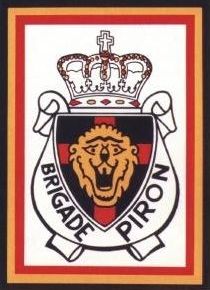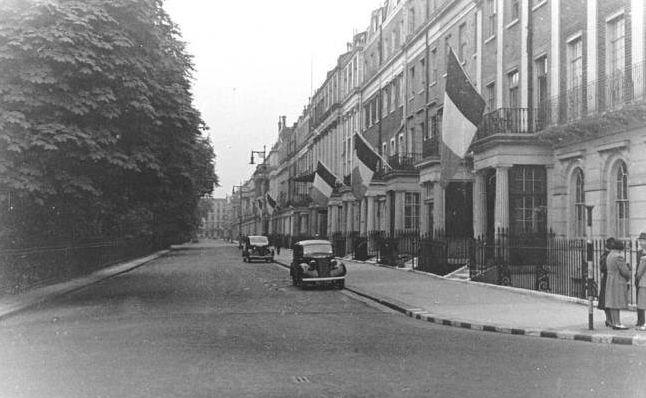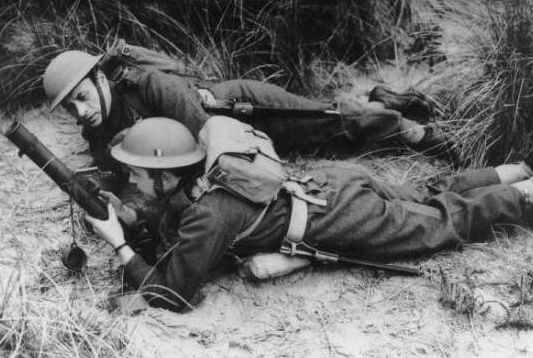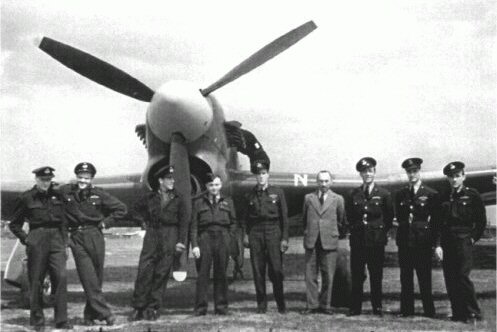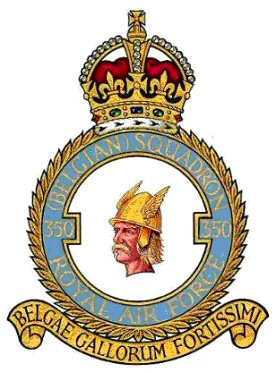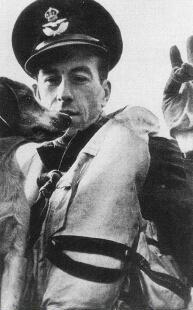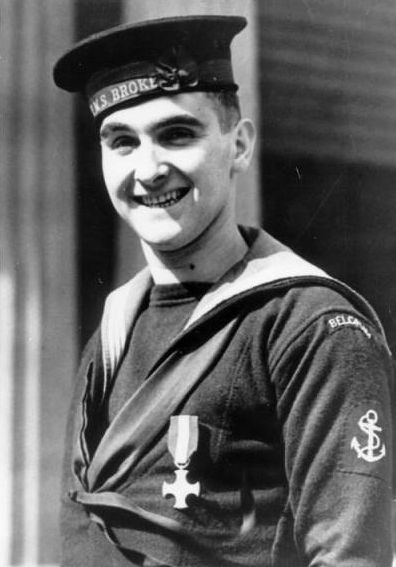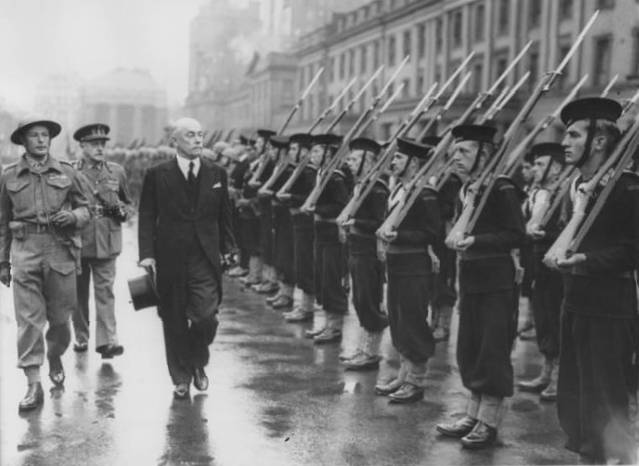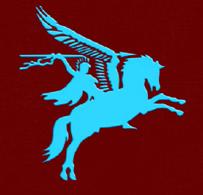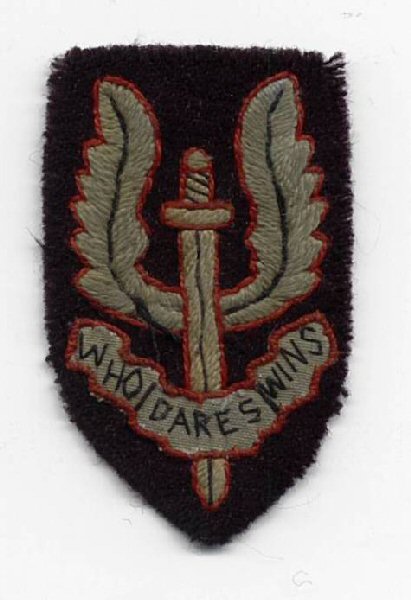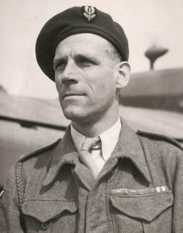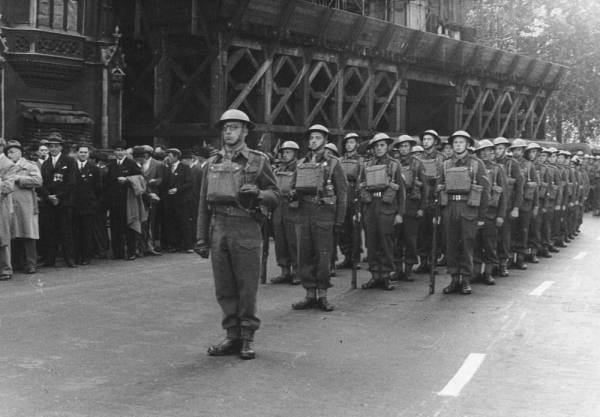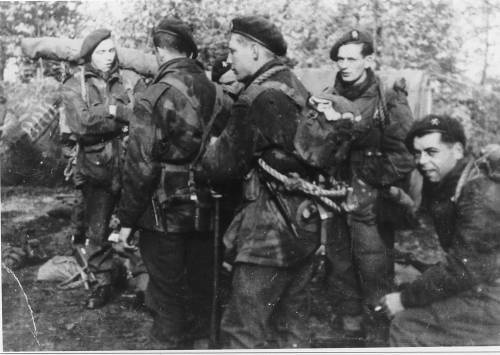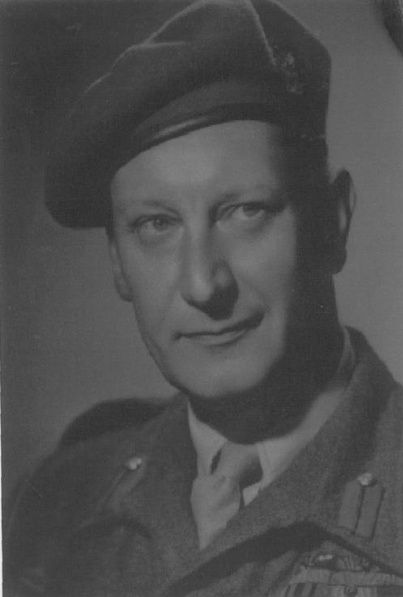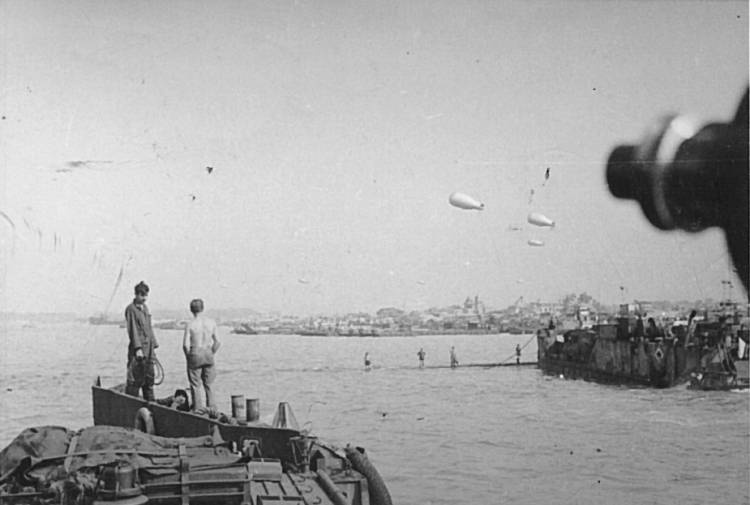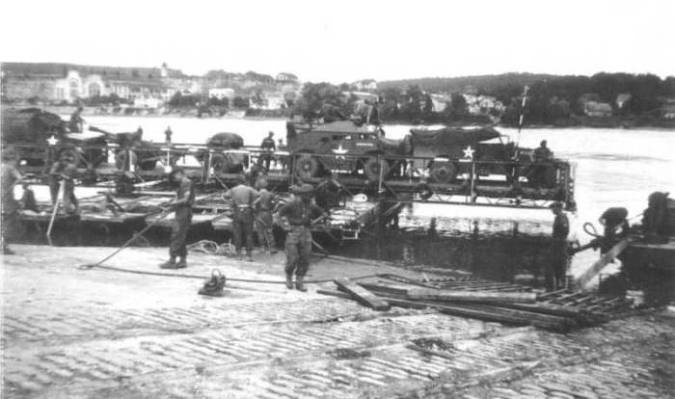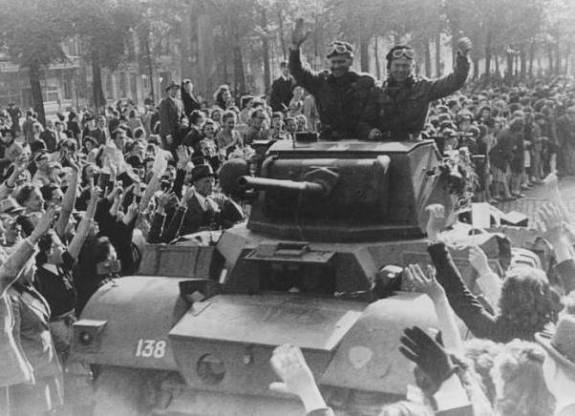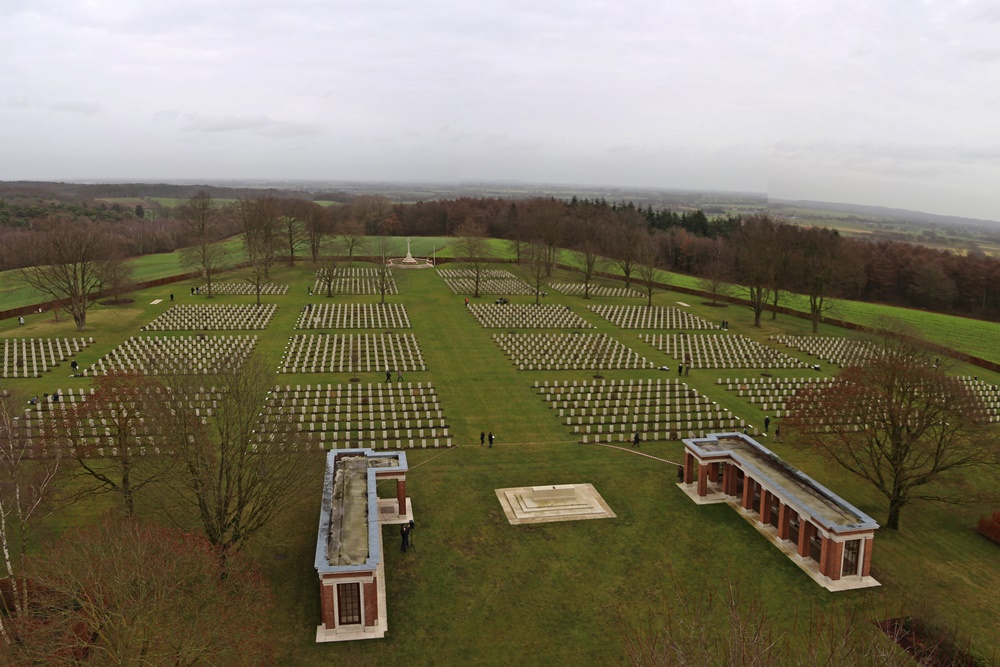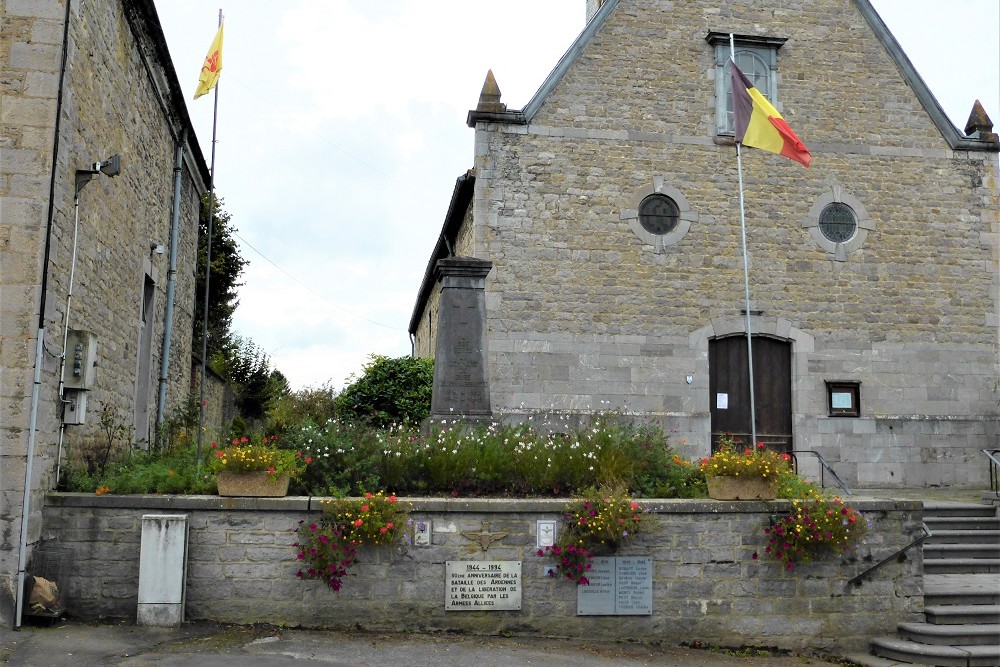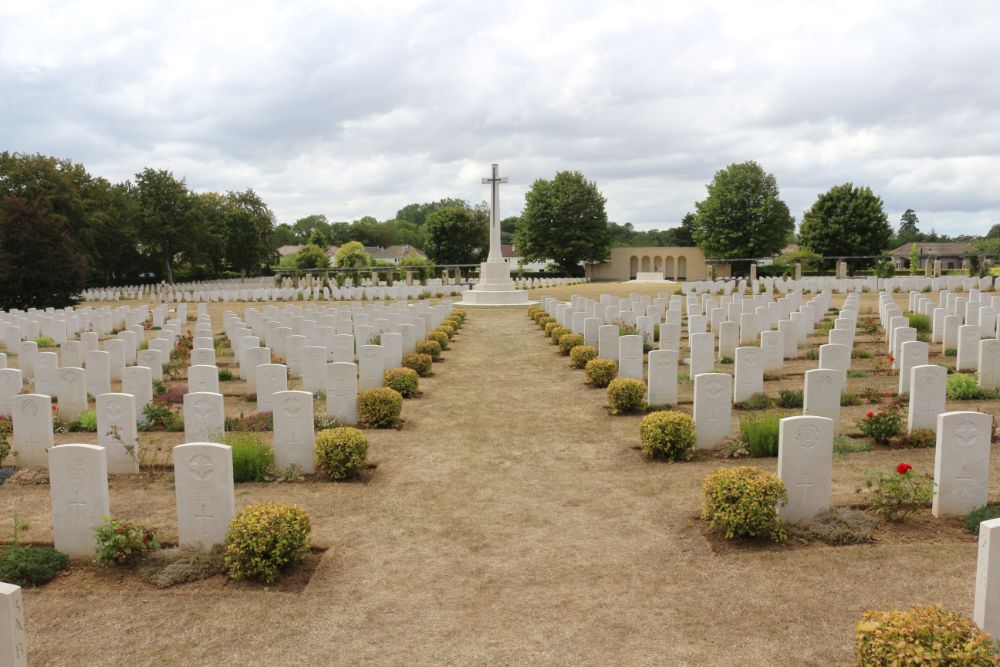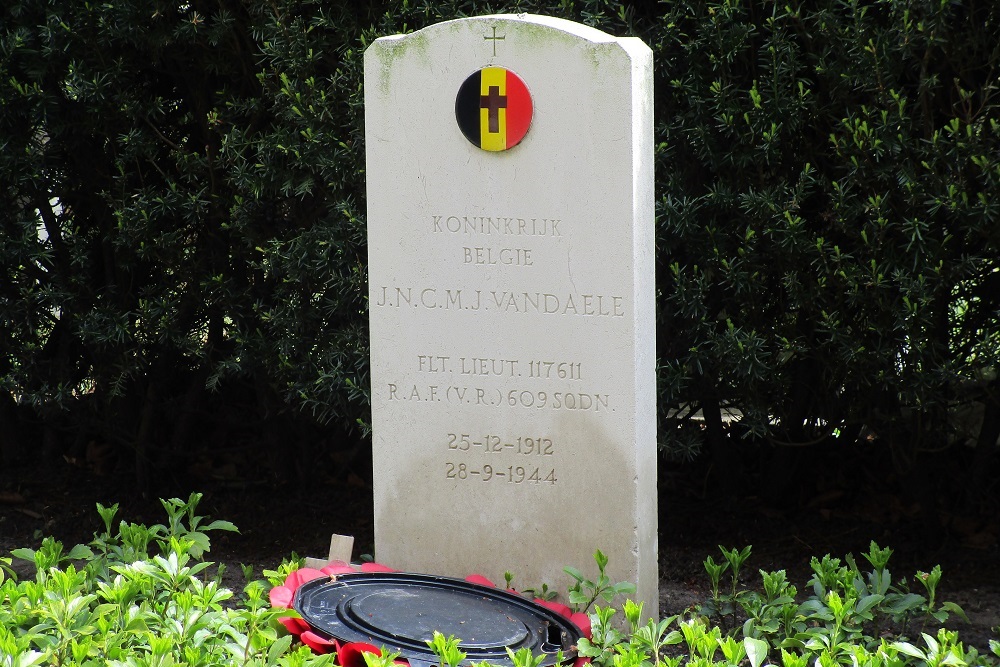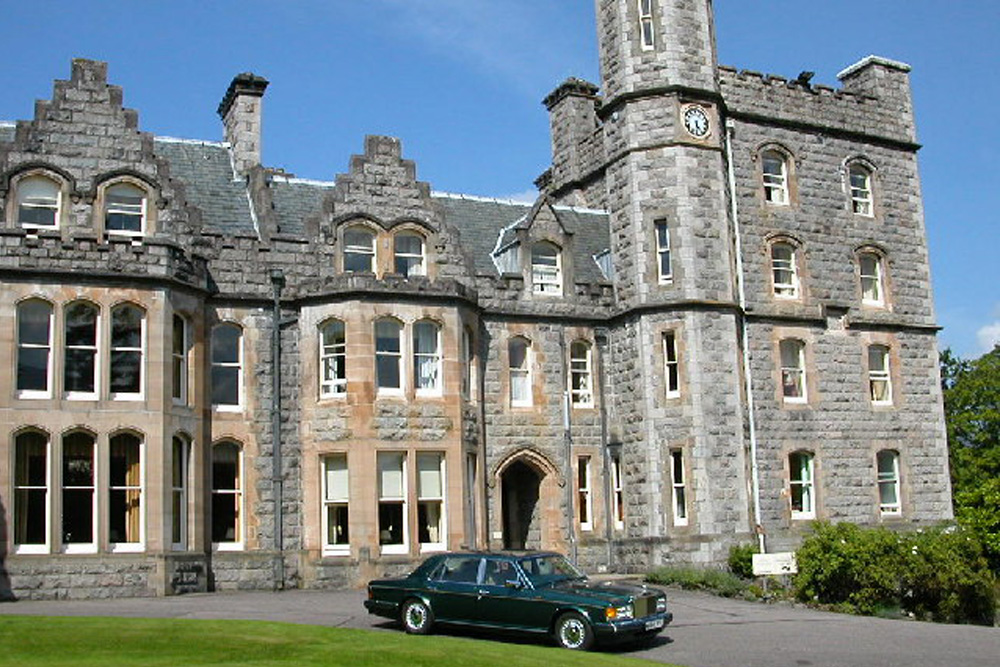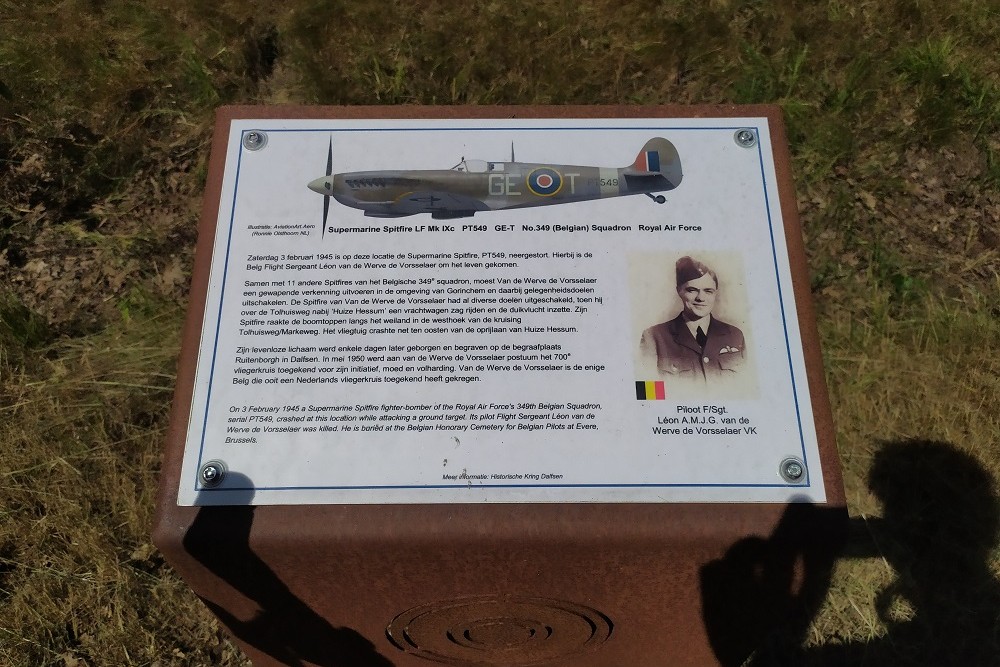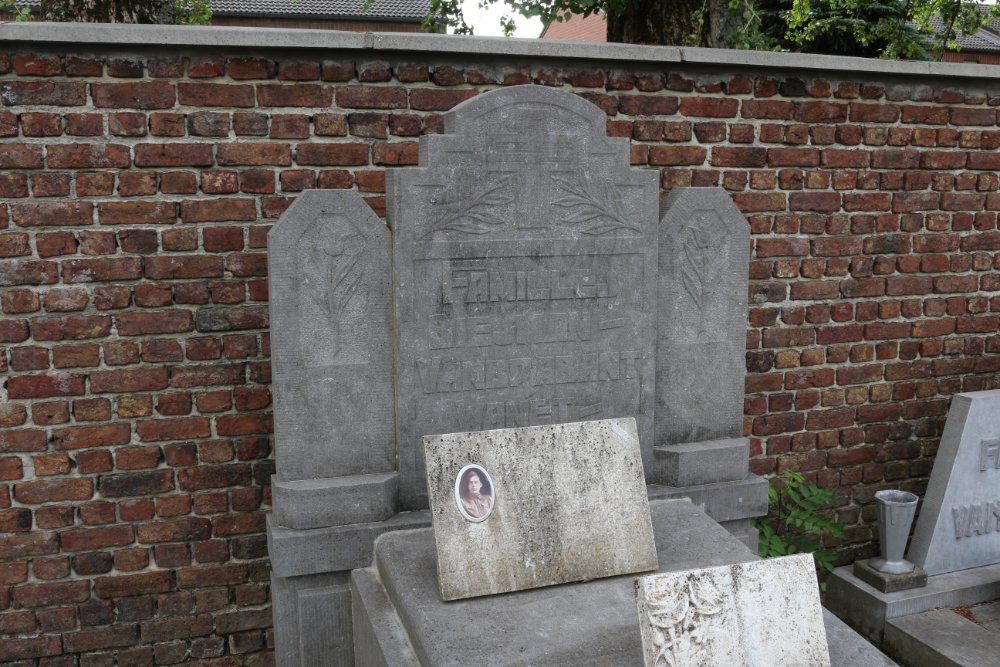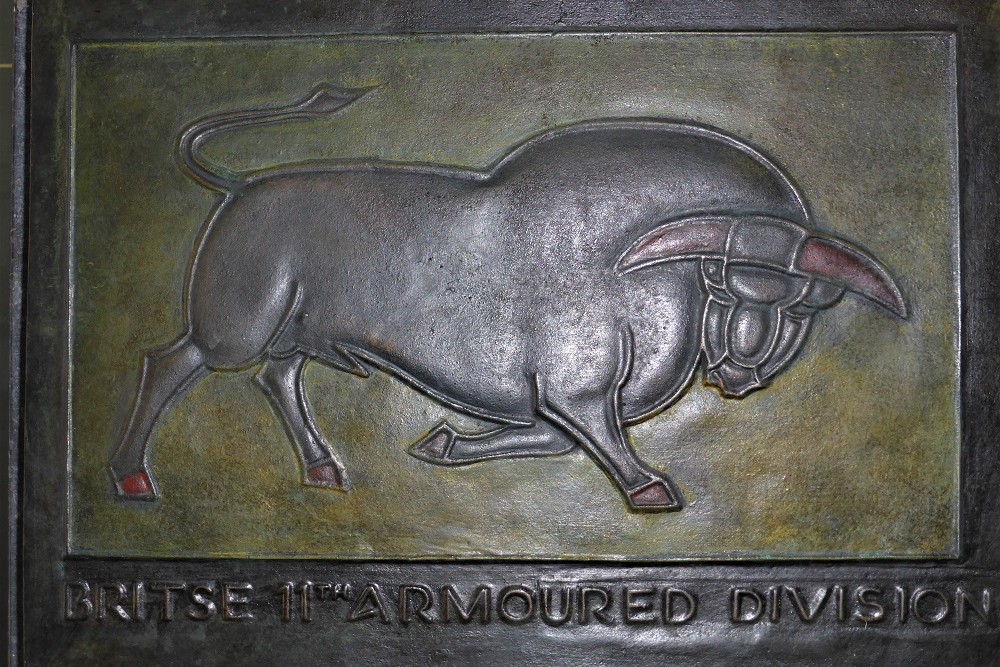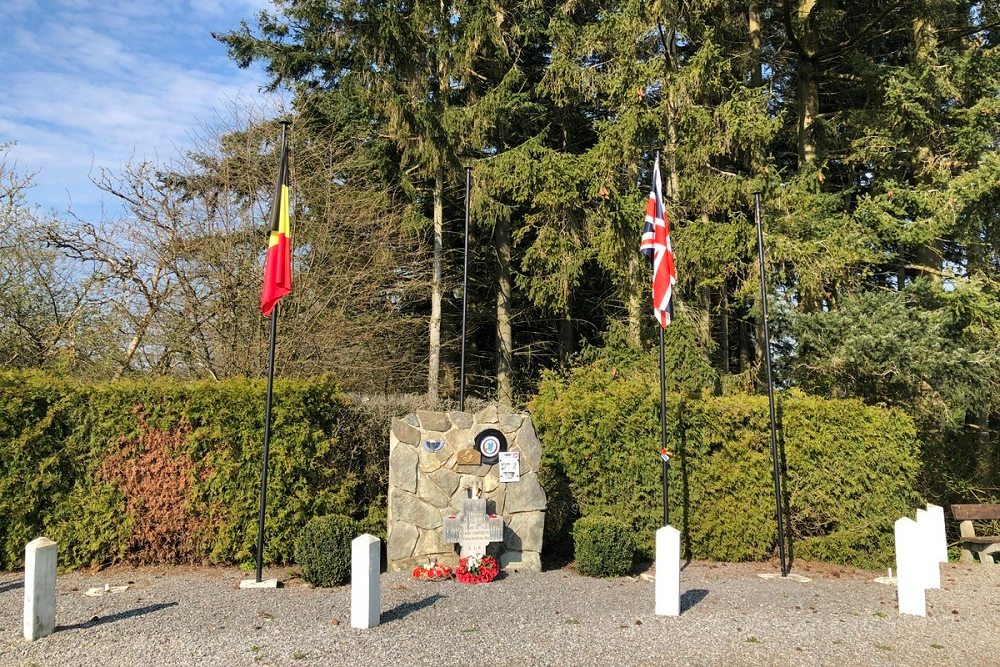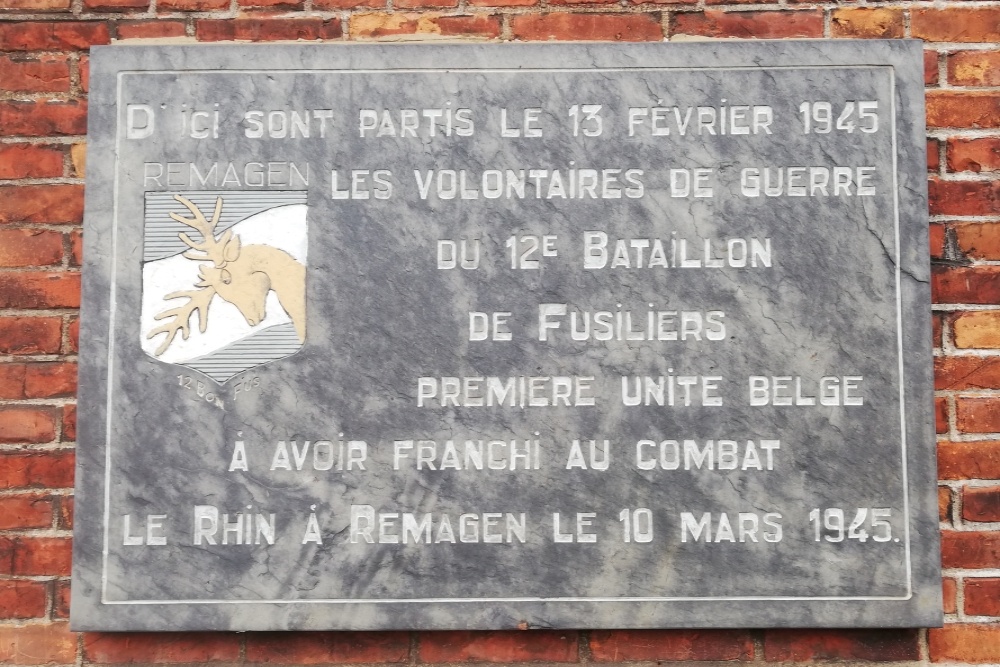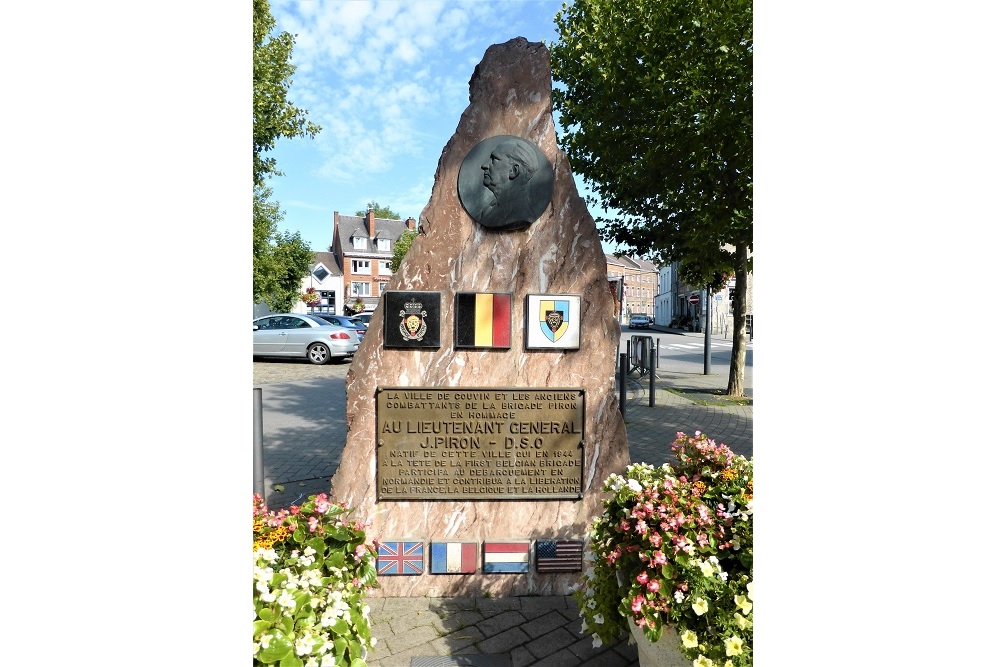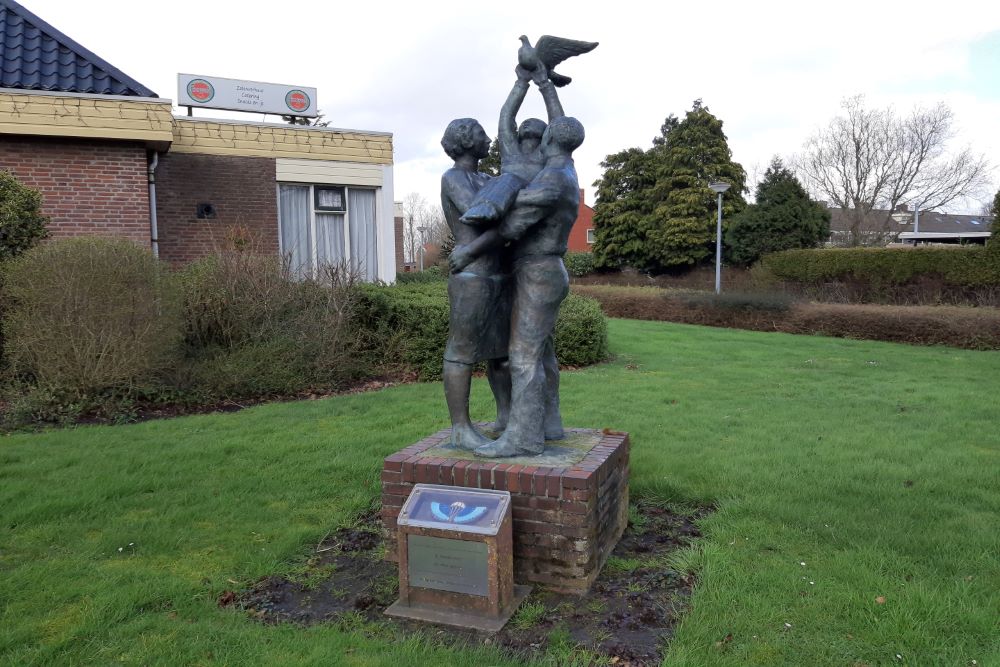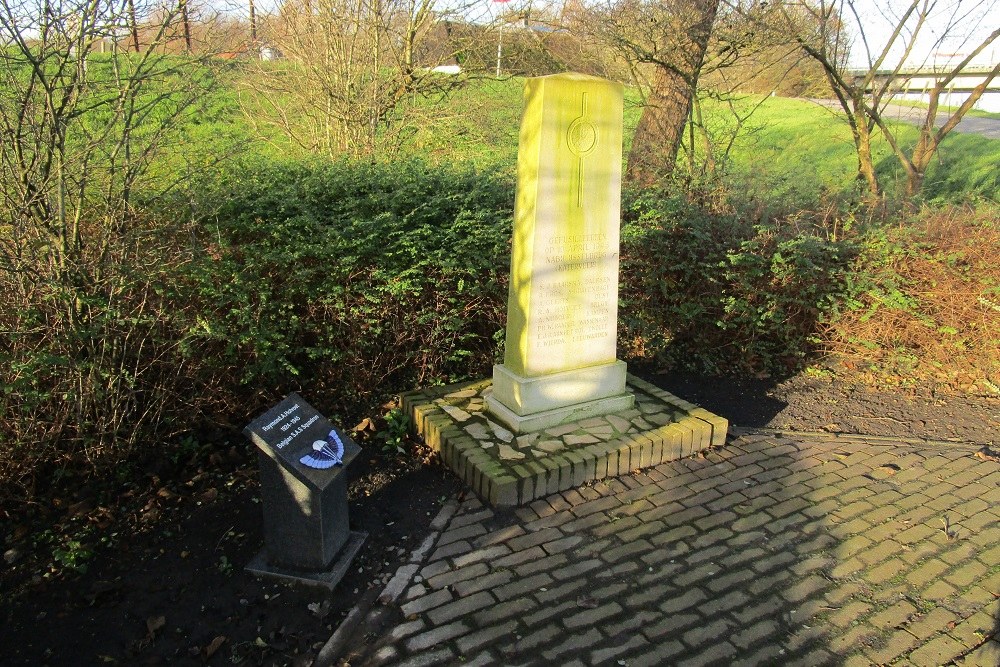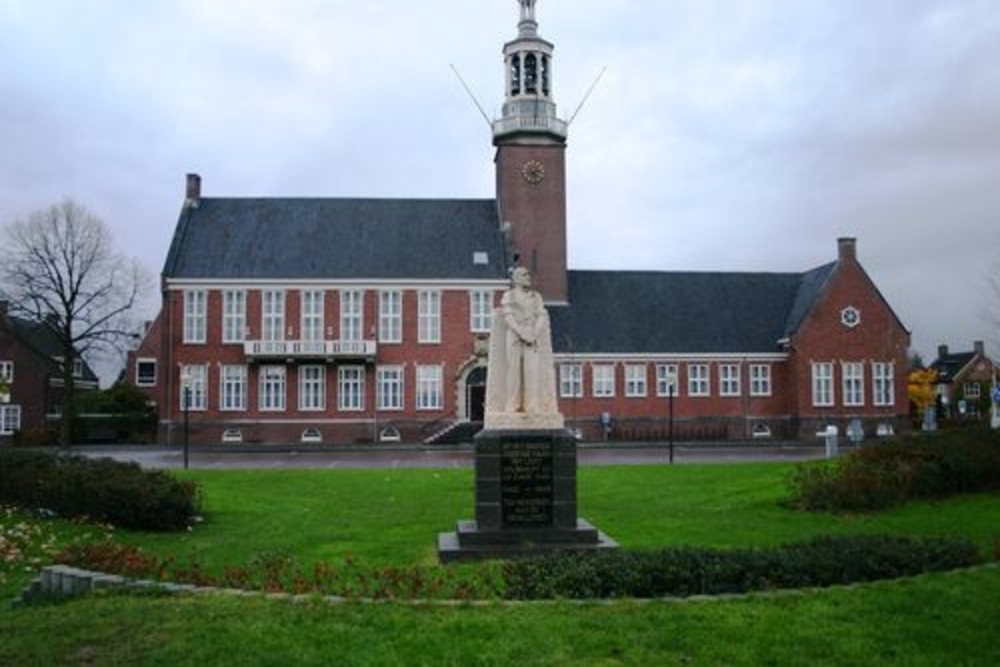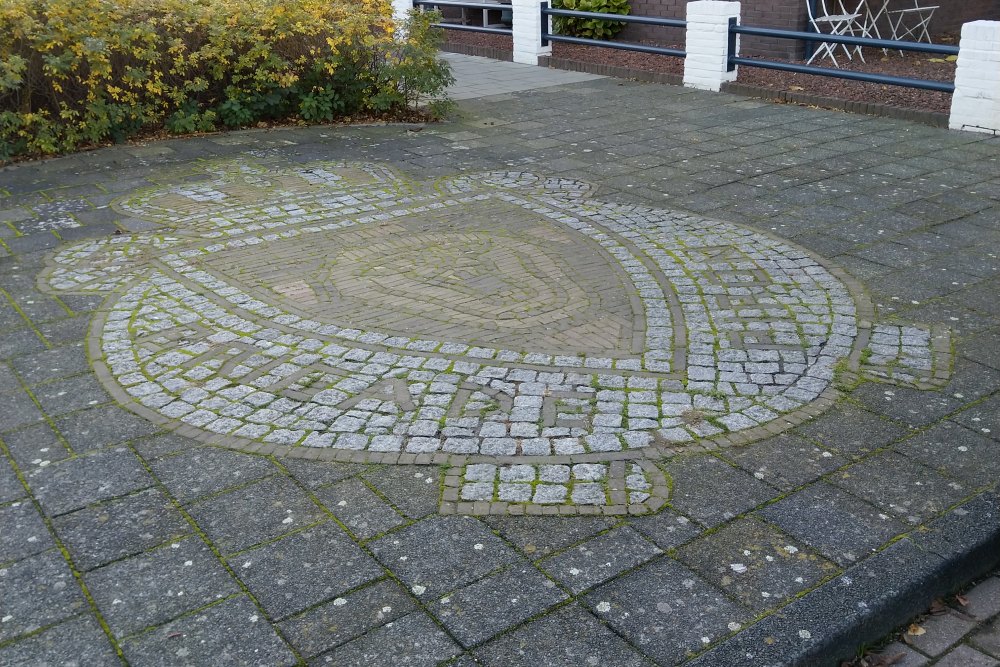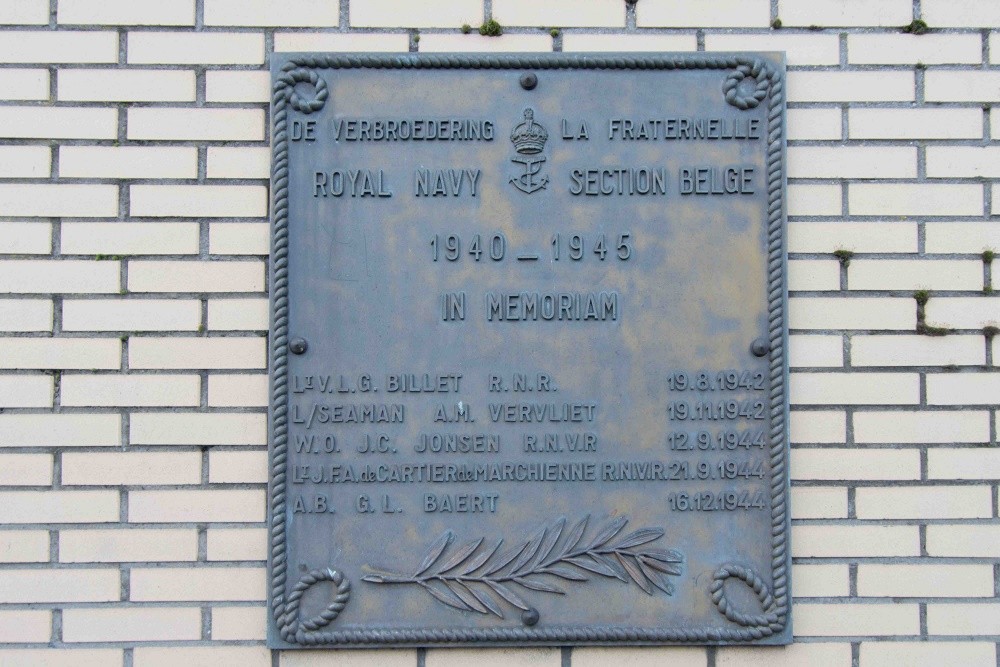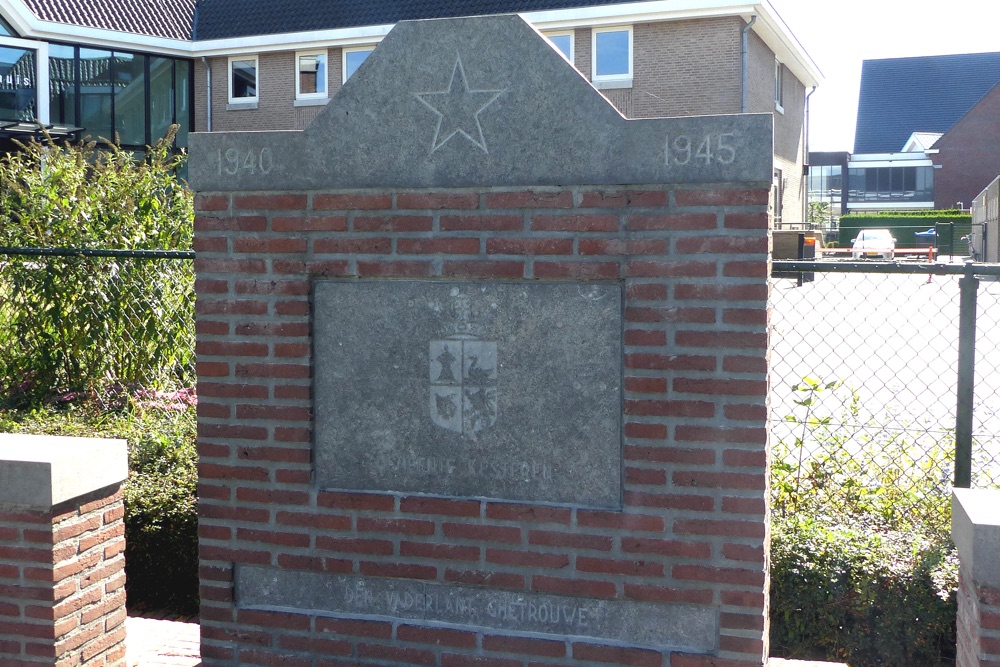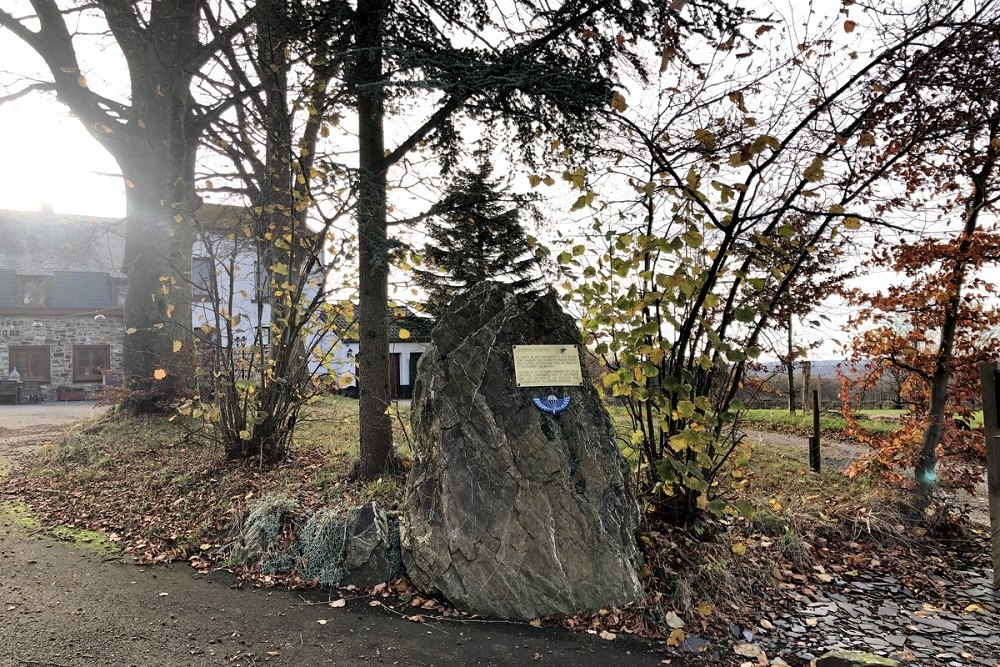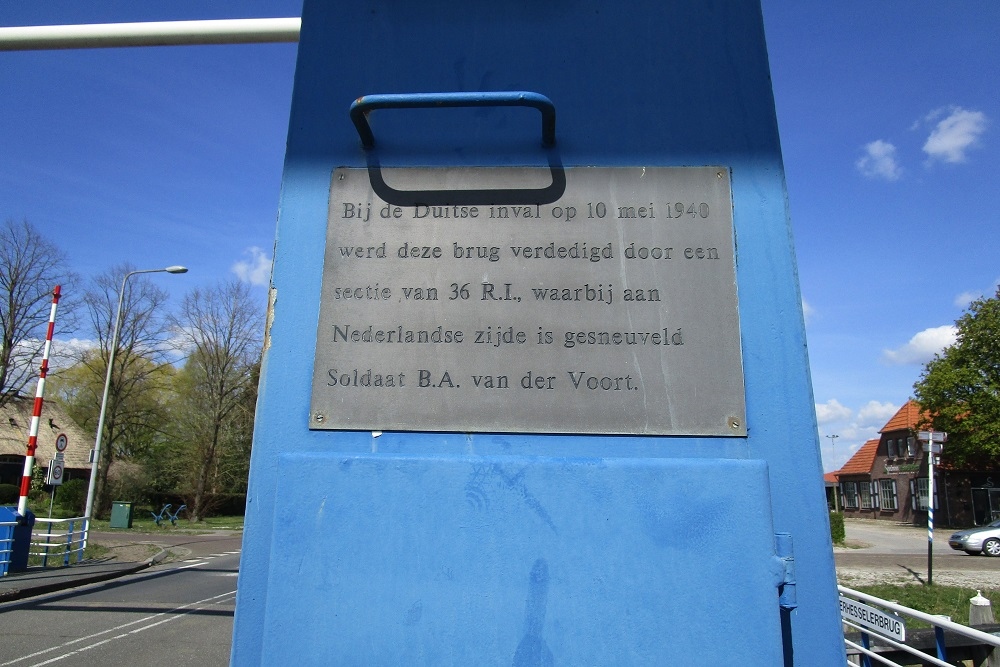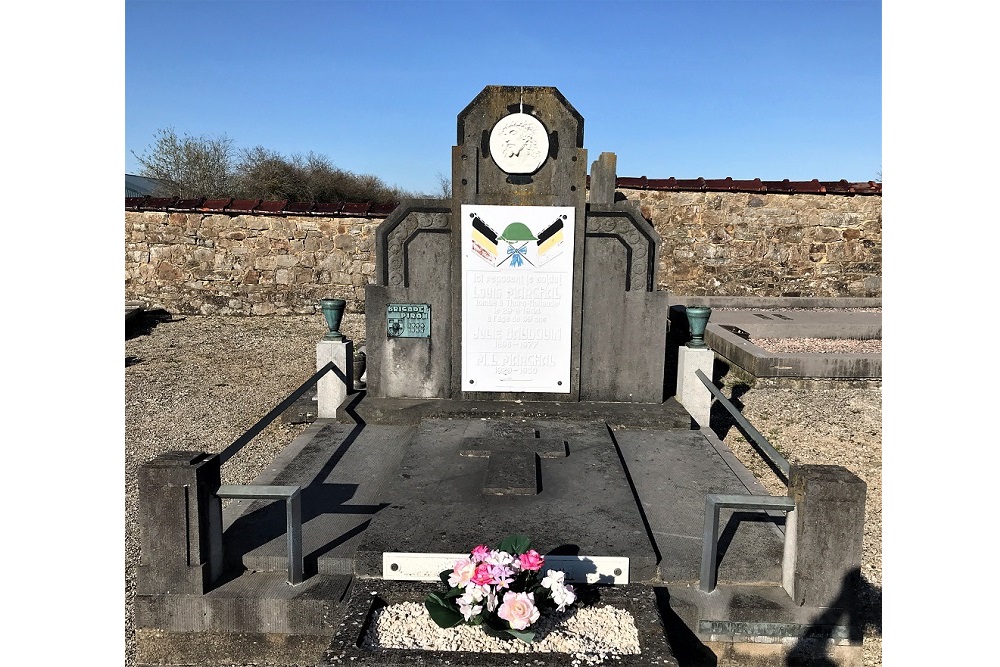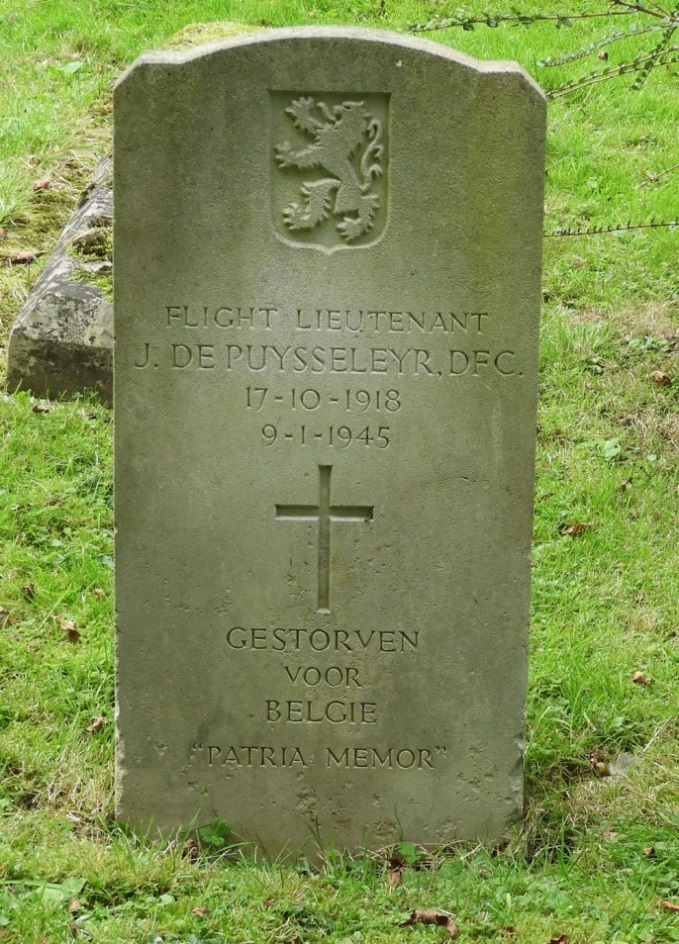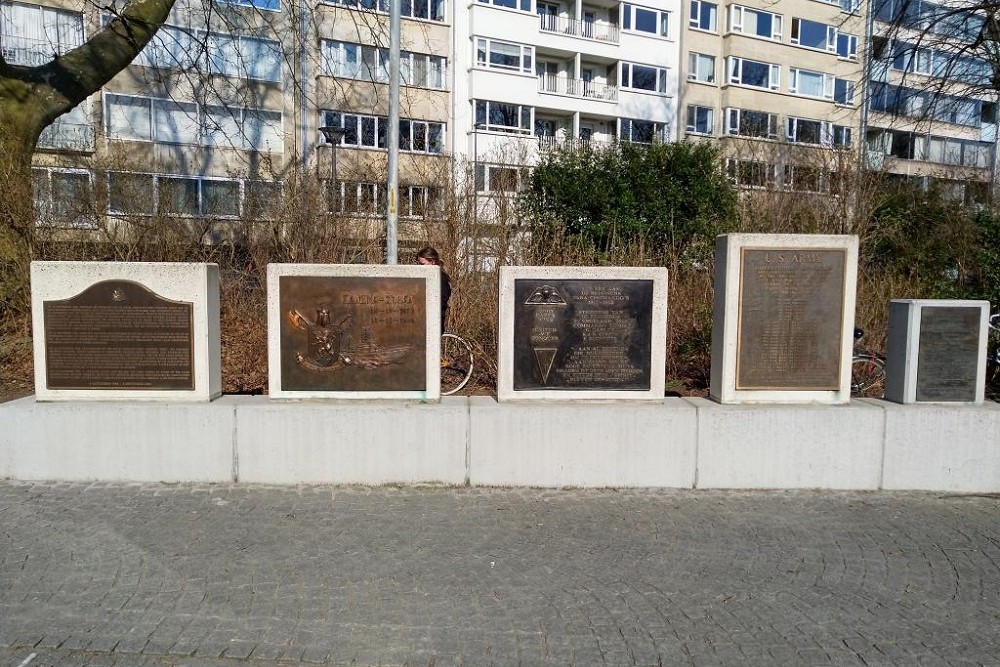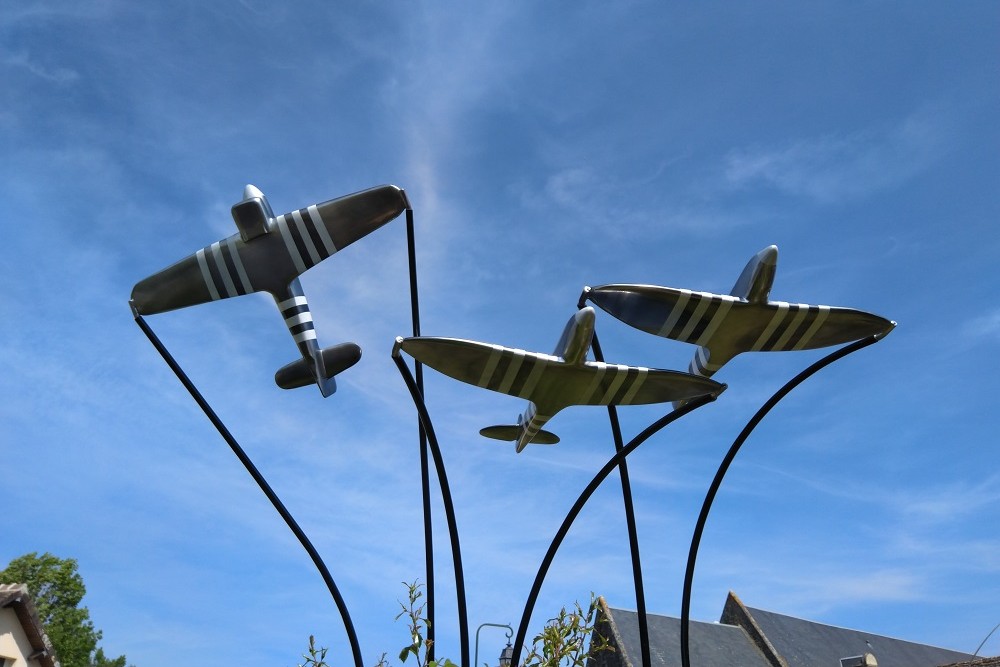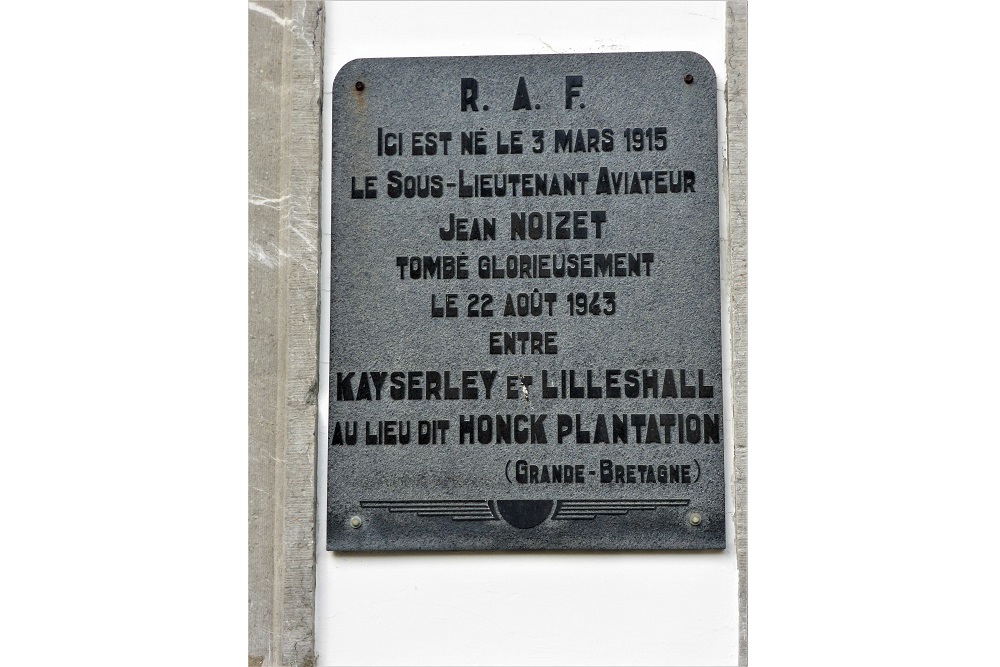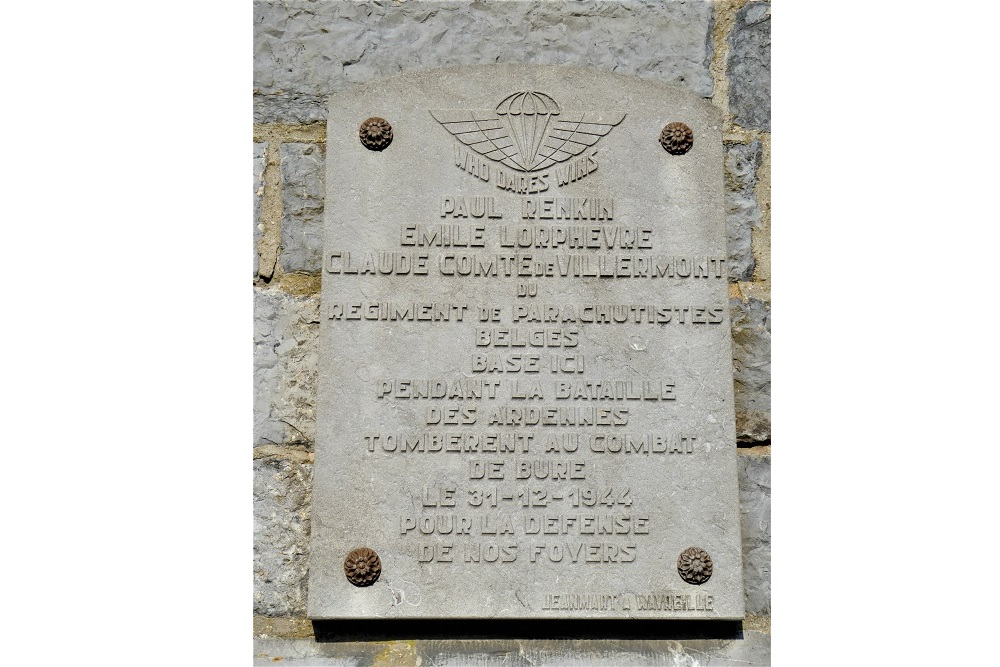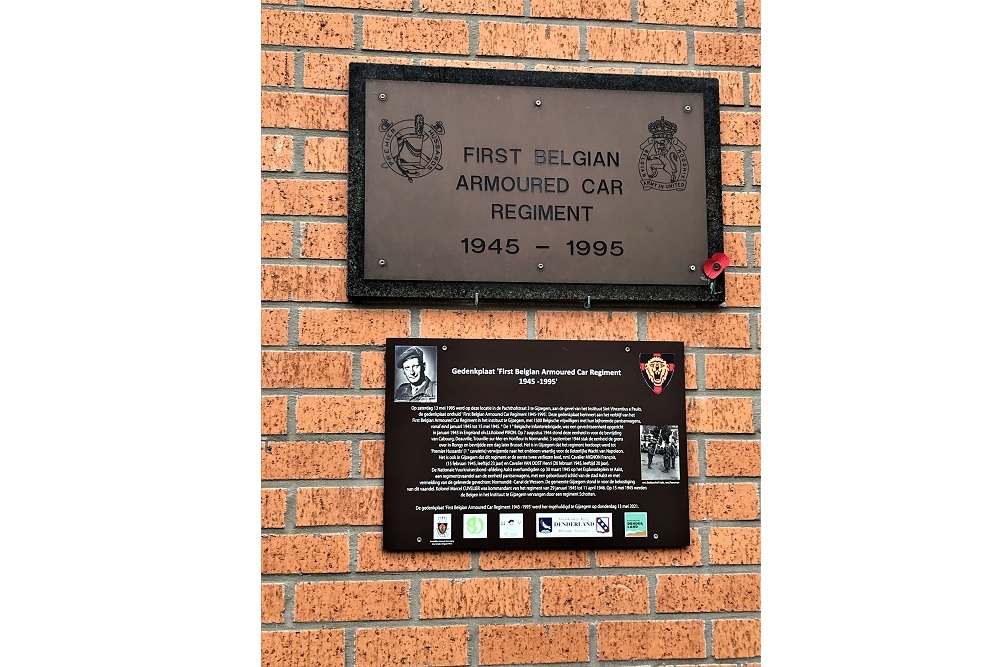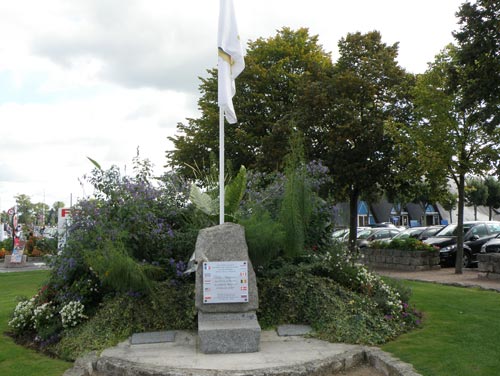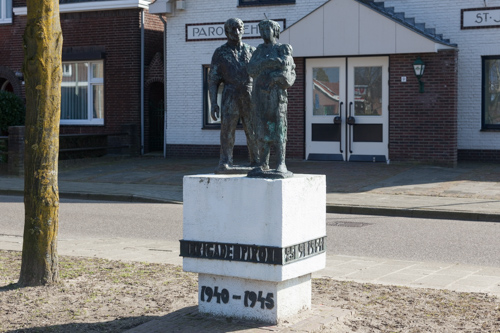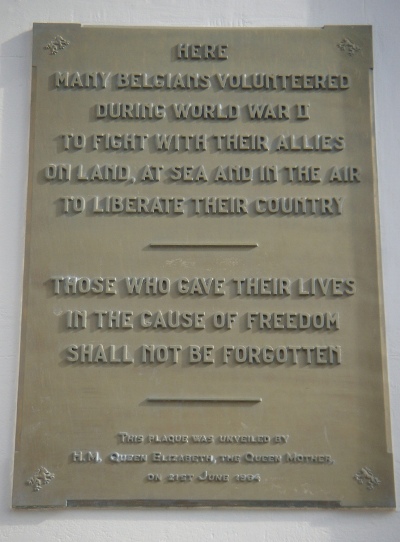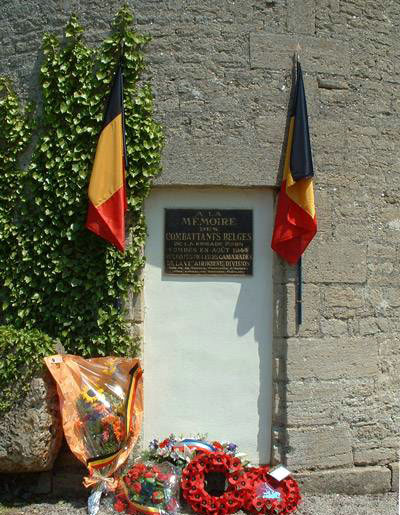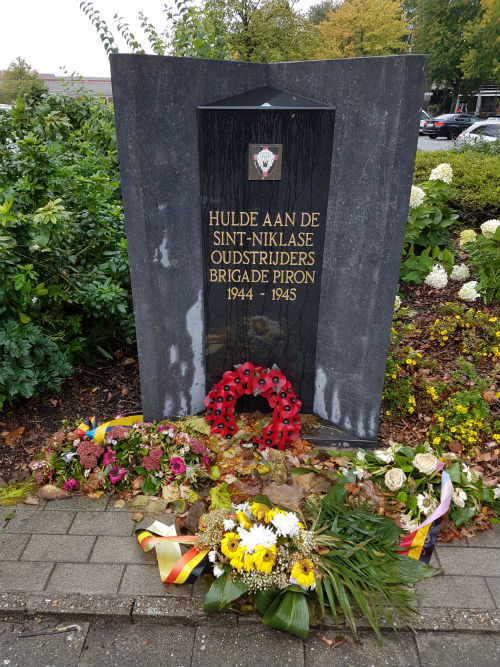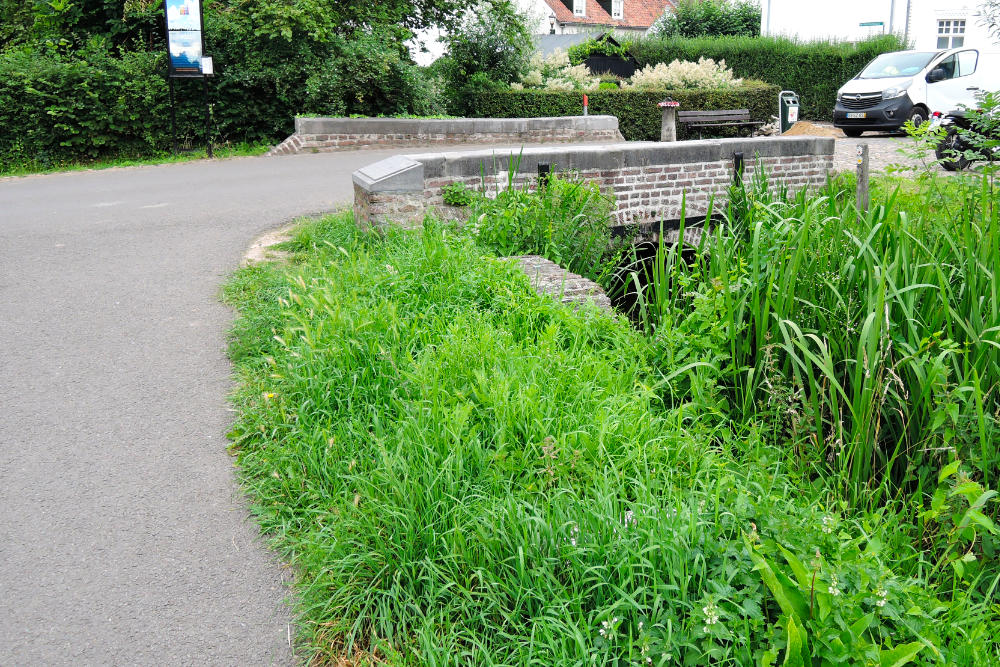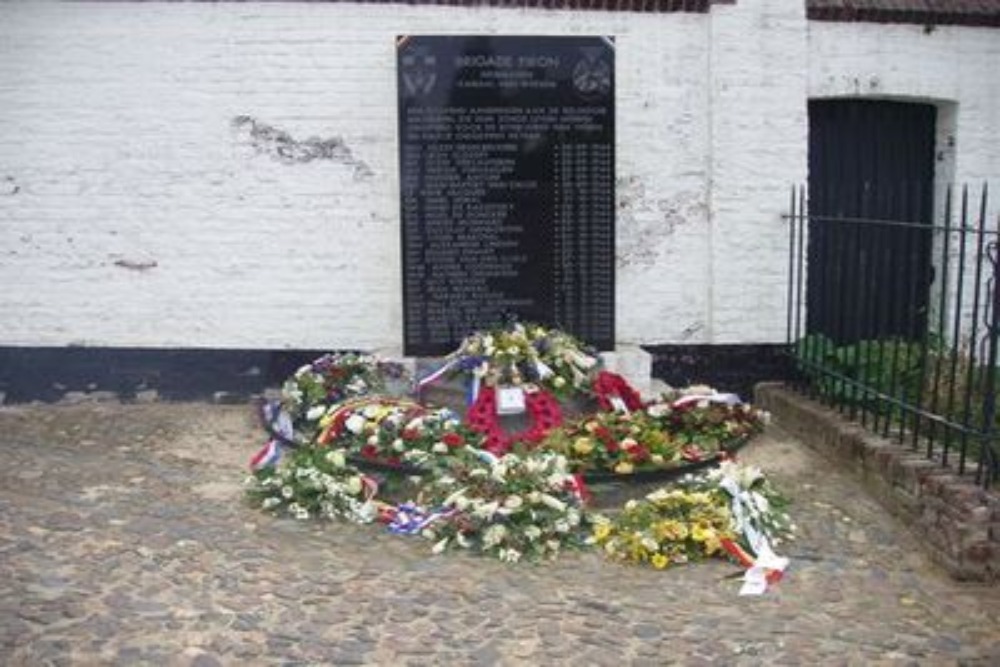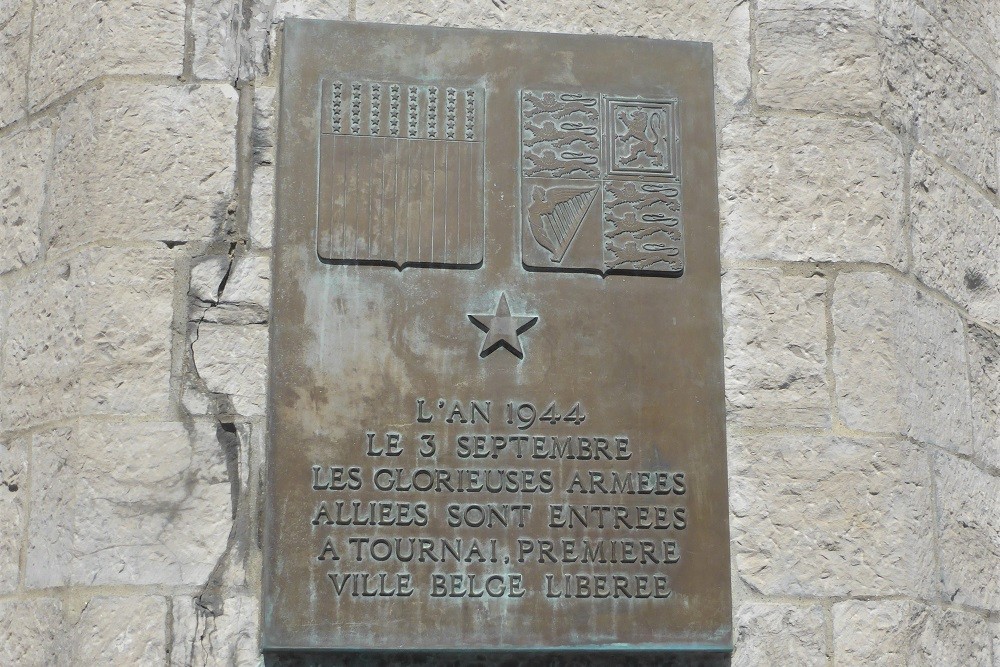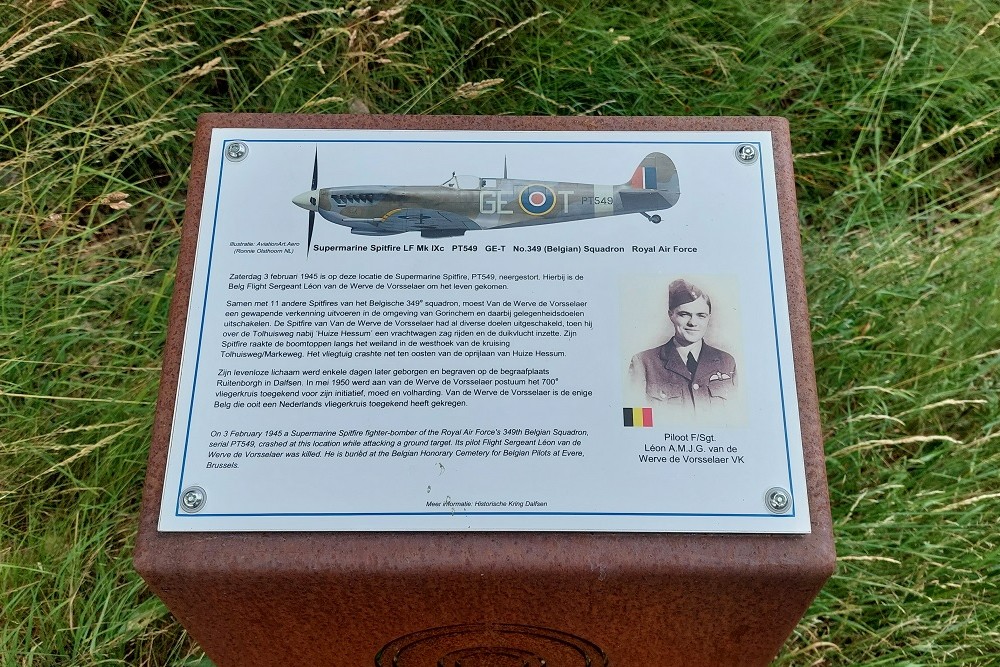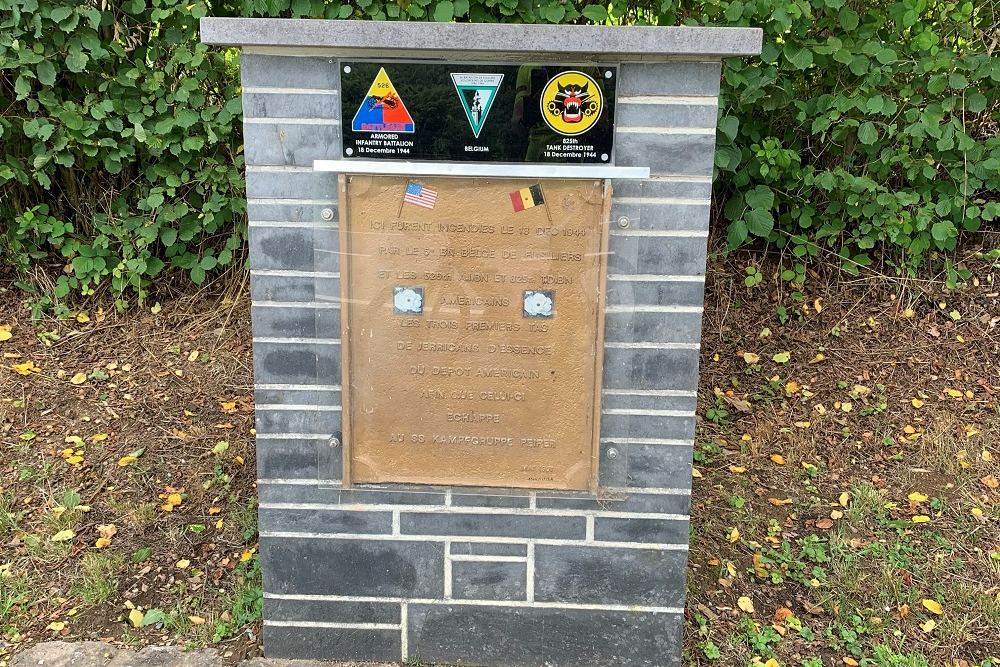Index
In this article a picture has been painted of the Belgian troops that continued the battle on the side of the allied forces after the capitulation on 28 May 1940. The most well-known unit of these troops probably was Brigade Piron, but next to them a lot more Belgians were participating in the fighting: in the RAF, in the Navy and even in the SAS and commando troops. The spotlight will be directed at each of these units.
Definitielijst
- Brigade
- Consisted mostly of two or more regiments. Could operate independently or as part of a division. Sometimes they were part of a corps instead of a division. In theory a brigade consisted of 5,000 to 7,000 men.
- capitulation
- Agreement between fighting parties concerning the surrender of a country or an army.
- commando troops
- Special forces, deployed especially for missions behind enemy lines such as sabotage and reconnaissance.
- RAF
- Royal Air Force. British air force
Images
Introduction
On the 28th of May, 1940, King Leopold III capitulated. The Belgian Forces surrendered to the German invaders. At that moment the most important Belgian public figures, like Prime Minister Hubert Perlot and Minister for Foreign Affairs Paul Henri Spaak, had already left the country. During the “Eighteen Days’ Campaign” a rift had developed between the government and the King. Leopold III had been convinced that the war on the continent had been lost already and that Belgium was facing a long lasting occupation. The Government on the contrary wanted to continue the battle and demanded that the King left the country together with them. He refused and thus the seed was sown for what became known as the “Royal dispute”.
In any case, most of the government members fled to London via France. Because they established on 28 May 1940, that the King was not able to govern, they drew all Legal and Enforcing powers towards themselves. The most important trump cards of the government were at that time Congo, rich with mineral resources and strategically well situated ( in the heart of Africa) and the national gold stocks of which the largest part had arrived in London together with the Minister of Finance Camille Gutt.
Just before and after the capitulation also a number of Belgian military arrived in Great Britain. They were all gathered at Tenby at the south coast in Wales. Ordered by the Minister of Defense Henri J. Denis Lieutenant-General Victor van Strydonck de Burkel was appointed to take charge of the organization of the BMHK (Belgian military regrouping camp). About 300 troops were brought together. Of these 124 were prepared to continue to fight. This kernel formed the UCB (Unité Combattante Belge – The Belgian Combat Unit) under the command of Edmond de Paepe. The real driving forces of the unit were lieutenant Richard Smekens and his adjutant Pierre Harboort. Van Strydonck was appointed commander of the Belgian military in Great Britain.
As there was not really very much enthusiasm for the new army unit, Minister Marcel-Henri Jaspar held a speech on the BBC, with which he called on all Belgians to choose the side of the allies and to join him in Great Britain. Following this call ever more volunteers that had escaped from Belgium or had fled from another country in Europe, reported in such numbers that in August and September 1940, various companies of Fusiliers could be set up. Two of those were applied to the coastal defenses of Wales.
The establishing of the new Belgian army however continued to develop with great difficulty. Nevertheless, the Belgians contributed more than their share in the allied war effort. There were quite a lot of Belgians with the British Navy and Air force.
Definitielijst
- capitulation
- Agreement between fighting parties concerning the surrender of a country or an army.
Images
With the RAF
After the capitulation a lot of Belgian pilots and pilots-in-training fled towards Great Britain. The Brits received them with open arms. They were immediately incorporated in Fighter Command or in Coastal Command. The Belgian assistance was more than welcome as the Battle-for-Britain had been launched in full intensity.
29 Pilots, incorporated in the RAF Volunteer Reserve, were joining the fight and downed 21 German aircraft. Buchin was the first Belgian who shot down a German war plane. The achievements of Jacques Philippart were even more striking: in twelve days he shot down five enemy aircraft before he himself was killed on 25 August 1940. In total six Belgians had to pay with their lives for their efforts during the Battle-for-Britain. At the start of 1941 fifteen Belgians were part of 609 Squadron. Jean Offenberg, Captain of that same squadron, was awarded the Distinguished Flying Cross (DFC). Daniël Le Roy du Vivier was the first non-British pilot who was appointed Squadron Leader. He also received the DFC.
Towards 1942 so many Belgian (apprentice) pilots had arrived in Great Britain that a complete Belgian squadron was established (the 350th). They gained quite a lot of fame by their participation in amongst others the raid on Dieppe and during the landings in Normandy. In November of the same year a second Belgian squadron was established, the 349th. This squadron was deployed in Africa at first but was later on transferred to Great Britain in order to be engaged in offensive operations over the European continent. Next to that, quite a lot of Belgians were serving in various units, amongst which the 609th Squadron.
The most notorious Belgian in British service is probably baron Jean Sélys de Longchamps. He served in Squadron 609, a special unit of the 11th Fighter Group charged with the defense of the British southern coast. Sélys de Longchamps participated enthusiastically in a number of risk taking operations over the English Channel, Belgium and France. His motivation was taking revenge on the Germans, especially on the the SIPO-SD (Sicherheits Polizei -Sicherheits Dienst = German secret service of the police department), because they were responsible for the death of his father. The headquarters of the Gestapo (secret service) in Belgium was established in an apartment building in the Louizalaan in Brussels. Jean de Sélys prepared his attack on the building carefully, but did not succeed to obtain permission from his superiors. Therefore he carried out his plans without permission. After he had completed a mission over Flanders he headed towards Brussels. With the deadly 20mm guns of his Typhoon he damaged the Gestapo-building severely. During the attack four Germans lost their lives amongst whom SS-Sturmbahnführer Alfred Thomas, Chief of the SD (Sicherheitsdienst = Intelligence). Tens of others were wounded. Because Jean de Sélys de Longchamps had acted on his own initiative, he was demoted, but he was extremely popular amongst the Belgian pilots. Later on he received the DFC for this action. He did not enjoy this award for a very long time as he was killed in action during a mission over Ostend in the night of 15 to 16 August 1943.
In total the number of Belgians in the RAF amounted to over 1200 men, both pilots and ground personnel. They were involved in large operations (the landings at Normandy, Market Garden) and were present at many a battle field (Birma, Africa, Mediterranean). In total the Belgian pilots achieved 161 victories; 201 Belgians lost their lives.
Definitielijst
- capitulation
- Agreement between fighting parties concerning the surrender of a country or an army.
- offensive
- Attack on a smaller or larger scale.
- RAF
- Royal Air Force. British air force
- raid
- Fast military raid in enemy territory
- SIPO
- ”Sicherheitspolizei”. Combination (since 1936) of the Gestapo and criminal police.
- Squadron
- A military unit in the Belgian navy usually six to eight small ships operating together under one command. The smallest military unit in the Dutch air force of about 350 men. In most countries is the designation of a military unit thesize of a company. It is either an independent unit, such as a battery, or part of a bigger Calvary unit. In the air force it is the designation of a unit of aircrafts.
Images
In the British Navy
Amongst the first Belgians who stepped ashore in Great Britain were a lot of sailors. When it became clear that Belgium and her allies were going to lose their battle with Germans, the government sent its navy (three squadrons), the merchant fleet and the fishing fleet to England. They also took along the majority of the national gold stock. These ships were immediately engaged in supplying the allied forces in the north of France and later on in the evacuation of Dunkirk. Sixty five Belgian ships participated in Operation Dynamo. The trawler from Ostend ‘George-Eduard’ carried more than one thousand men in two trips, whilst also smaller fishing sloops transported hundreds of soldiers back to Great Britain. The fisherman from Zeebrugge, George Franҫois Regard, even received for his actions the Distinguished Service Cross (DSC) from the British King.
By the end of 1940, the British Admiralty allowed several hundreds of Belgian sailors to serve in the British Royal Navy. Under the command of lieutenant Victor Billet a Belgian section was established in Devonport. The officers and sailors of this section crewed two corvettes the ‘Buttercup’ and the ‘Godetia’. They served in convoys on the Atlantic Ocean till December 1944. Before the landing in Normandy a flotilla of minesweepers, the 118th, was established with a complete Belgian crew. Next to that the Belgian section also had three patrol craft, the ‘Phrontis, the ’Elektra’ and the ‘Kernot’. Victor Billet was the only Belgian who was killed during the failed allied landing at Dieppe on 19 August 1942. He had boarded a British landing craft which was hit by German fire.
In October 1944 the 118th Flotilla received orders to sweep the shipping lanes in front of the Belgian coast in order to prepare the amphibious landing at Walcheren (the Scheldt estuary). Afterwards the minesweepers participated in the clearing of the river Scheldt, before they sailed into the port of Antwerp on 28 November 1944 in front of the first supply convoy.
Although the majority of the Belgian sailors participated in the Belgian section of the Royal Navy, a large number of officers, midshipmen and ordinary sailors served onboard of all various types of ships of the Royal Navy. Next to that about 4000 men served onboard of around one hundred allied merchant ships. They sailed on the Mediterranean, the Atlantic and the Indian Ocean.
Definitielijst
- Billet
- To lodge soldiers in a particular place, especially a civilian's house.
Images
The SAS-troops
On November 8th, 1940, the first Belgian Battalion was established in Great Britain. By end December it reached its full strength with 825 officers, warrant officers and men. Charles Cumont the 37 year-old Captain was in charge of the supreme command. Gradually the Belgians got more and more equipped with the establishment of an artillery battery and a squadron of armored cars. On 20 February 1941 the battalion left Tenby in order to be transferred to Carmarthen. Only the staff of Lieutenant-General Van Strydonck, some services and the instructors remained at Tenby.
On February 23rd, 1941, a second battalion was established, commanded by Reserve Captain William Grisar. The new battalion was based in Malvern. On 10 July 1941 the military staff and the remaining men from Terby were transferred to Malvern. This was from now on the headquarters of the ‘Belgian Independent Infantry Brigade’.
During a number of months maneuvers alternated with the classical ‘military training’. Because the allied forces recognized that paratroops were a new weapon in warfare they started to train parachutists. Early 1942 a number of soldiers of the 1st Fusiliers battalion started a training as parachutist at Ringway. Soon eight men were admitted to be called the first Belgian licensed paratroopers. From then onwards each month some twenty volunteers were trained. On 8 May 1942 the Belgian Independent Parachute Company was established officially by Henri Rolin, Undersecretary of State for Defense. When the first commander, Jules Thise, became seriously wounded on his spine during a jump, the command was transferred to Captain Edouard Blondeel.
In August 1943 the parachutist company was doing practice with the 6th Airborne Division and on 2 December 1943 the Belgian paratroopers moved to Scotland to the ‘Special training Center’ in Inverlochy Castle. There they were trained to become SAS-paratroops. The number of trainees at that moment amounted to 210 men. On 24 February 1944, the Parachutist Company was incorporated in the ‘Special Air Service Brigade’ together with two British and two French units and were named the ‘Belgian SAS Squadron’. Even when Captain Blondeel was in charge of the unit since a year and a half, he only took officially command of the squadron on 8 February 1944. At that time they left their encampment at Friz Hill-Kineton in order to be installed in Camp Loudon Castle near Galton (Ayrshire) in Scotland.
The task of the SAS units involved the sabotage of (communication) connections, to gain intelligence and to collaborate with resistance groups. Originally it was the intention that the Belgian SAS-unit had to be dropped in the Ardennes, just before the landing in Normandy but this plan was canceled at the last moment. Finally the Belgians were only deployed in July and August in the hills of Perche (Operations Chaucer, Bunyan and Shakespeare). The first teams consisted of six men. They had to collect as much information as possible about the German movements and positions. Next to that they also participated in attacks on the German columns and rear guards.
When the allied advanced forces had reached them they were carried back to their starting point. On 17 August 1944 eighty Belgian SAS men left in order to participate in Operation Trueforum. They were dropped in the Falaise pocket and had to prevent as much as possible the German withdrawing troops from crossing the Seine river. In the same period a reconnaissance group under the command of Lieutenant Etienne Kirschen was dropped east of Beauvais with the orders to send messages about the volume of the German transports along the axes Paris – Compiegne and Paris – Soissons (Operation Benson). They were dropped in the wrong place but they succeeded to obtain a document with the total German battle order along the river Somme. Next to that they liberated some two hundred allied aircrew that had been shot down and brought them back to their own lines.
During the same period a team of eight SAS paratroopers jumped under the command of Lieutenant Renkin as a spearhead of Operation Noah (reconnaissance patrols and attacking of German withdrawing troops) in the French Ardennes. They were the first Belgian soldiers that penetrated into Belgian territory where they had to prepare the arrival of the advancing allied forces. In cooperation with the so-called Secret Army (Geheim Leger) they succeeded in generating big losses with the Germans in manpower, vehicles and ammunition dumps.
Thereafter the Belgian SAS-troops were parachuted into an action theatre which reached from Gedinne in the Ardennes till Peer in (Belgian) Limburg, where they stayed on until the allied ground forces arrived. During one of these operations (Bergbang) the team of Lieutenant Vanderheyden was dropped in the wrong dropping zone and landed as the first allied military in Germany (West of the Siegfried Line) . After this bad drop they immediately returned to Belgium in order to as yet carry out their orders. In Sart they attacked a German headquarters. One high ranking officer was killed. Some groups in the Ardennes operated in their parachuted jeeps equipped with Vickers machine guns. This happened amongst others in Bois-Saint-Jean (Luxemburg) where, after heavy fighting, they repelled an enemy attack with armored vehicles.
On 13 September 1944 the various Belgian SAS groups gathered in liberated Brussels from where they were carried back to England. They were soon deployed again amongst others during Operation Market-Garden and during the Battle of the Bulge. Their many actions earned the Belgian SAS the notices “Normandy-Belgium-Ardennes-Emden-Oldenburg”, which became marked on their ensign and on the emblem of their unit as well as the achievement of the “Shoulder-knot of the Order of Leopold” (Third class). This decoration was submitted to units that have at least four citations on their emblem. In total sixteen men lost their lives and fifty eight were wounded
Definitielijst
- Brigade
- Consisted mostly of two or more regiments. Could operate independently or as part of a division. Sometimes they were part of a corps instead of a division. In theory a brigade consisted of 5,000 to 7,000 men.
- Division
- Military unit, usually consisting of one upto four regiments and usually making up a corps. In theory a division consists of 10,000 to 20,000 men.
- Infantry
- Foot soldiers of a given army.
- paratroopers
- Airborne Division. Military specialized in parachute landings.
- resistance
- Resistance against the enemy. Often also with armed resources.
- squadron
- A military unit in the Belgian navy usually six to eight small ships operating together under one command. The smallest military unit in the Dutch air force of about 350 men. In most countries is the designation of a military unit thesize of a company. It is either an independent unit, such as a battery, or part of a bigger Calvary unit. In the air force it is the designation of a unit of aircrafts.
Images
The Commando units
In the spring of 1940 the British had established some small storm troop units. These units had been trained to carry out raids in enemy territory. From 1942 the British recruited also foreigners that lived in Great Britain. Also Belgian soldiers were involved in this. The command of the Belgian “Troop” was carried by Reserve-Captain Georges Danloy. They were housed in Abersoch in Wales, where they moved in with civilians for lack of barracks. In August 1942 seven officers and 85 volunteers left for the Commando base training center in Achnacarry in Scotland. After their training they became part of the international unit “Nr 10 Inter Allied Commando”. With a British headquarters this was composed of eight “Troops”: the 1st and the 8th French, the 2nd Dutch, the 3rd Israelian, German and Austrian soldiers who had fled the Third Reich, the 4th Belgian, the 5th Norwegian, the 6th Polish and the 7th Yugoslavian Troop.
On 10 September 1943 Troop nr 4 left for Algeria. There they received an additional training of six weeks in the camp of Bir-Kadem in order to be deployed for the first time in Italy. Herewith it was the first Belgian ground unit that resumed the battle in Europe after the capitulation in May 1940. On 2 December 1943 the unit landed at Taranto, where they were sent to the front along the river Sangro as part of the 8th British Army. Their tasks consisted mainly of going on patrol and attack actions. They also participated in the attack on Petrili. One month later the Troop was sent to the front of the 5th American Army. There the Belgian Commandos gained a famous reputation during the fighting along the defense lines of the river Garigliano. Together with the rivers Liri and Gari this river was the center of the German defense lines in Italy of which the Gustav Line is the most well-known. The Belgians received an honorable mentioning in the day order of the army: “The Belgian commando-unit has carried our colors with pride on the battle fields of Italy, where it received the nicest recognition of the chiefs under whose command they proved the value of our weapons, for its enthusiasm, especially during patrols in San Pietro and Montenero and during the attacks on the Gustav Line in Tremensuoli and Monte Ornito.”
After having spent approximately three months at the frontline, Troop nr 4 was transferred on 4 February 1944 for a short time to the rear guard in order to recover. On 14 March 1944, the Belgian commandos departed for the Island Vis in the Adriatic. They fought on the side of the Yugoslavian partisans of Tito during the amphibious landings on the islands in front of the Dalmatian coast and during attacks at German supply convoys in the Adriatic Sea. The Belgians earned herewith a second honorable mentioning.
About two months later the Troop was again in Naples. They returned to Great Britain where they received reinforcements and training. That’s why they did not participate in the landings in Normandy. On 25 August 1944 they were deployed with a raid on the Island of Yeu near Saint Nazaire but the Germans had already withdrawn from the island. The war was coming to an end, but the most difficult job had still to come. The allies were in September 1944 in great difficulties especially regarding their logistics. The port of Antwerp could still not be used as the Germans still occupied the islands at the entrance of the Scheldt estuary. The Belgian Troop was put under the command of the 4th Commando brigade. The Belgians would be part of one of the largest amphibious operations namely the landing on Walcheren (Operation Infatuate). Their attack started on November 1st 1944: they landed at Westkapelle and Domburg. They captured their targets but at cost of one quarter of their men. The actions of the Belgians did not go unnoticed: they received a third honorable mentioning in the army- day-order.
Afterwards the Belgian commandos returned to Great Britain. Replenished with new recruits the unit was divided into three Troops, the 4th, the 9th and the 10th. The whole of the unit remained under the command of George Danloy who had been promoted to Major in the meantime. In April 1945 the commandos were in Emsdetten (Germany) as part of the 1st Commando Brigade. From there they moved to the Baltic Sea. On their way they arrested Major Hellebaut of the 28. SS-Freiwilligen-Panzergrenadier-Division Wallonien. On 5 May 1945, a few days before the German capitulation, the Belgian Troops arrived in Lübeck before they reached the Baltic Sea.
Definitielijst
- brigade
- Consisted mostly of two or more regiments. Could operate independently or as part of a division. Sometimes they were part of a corps instead of a division. In theory a brigade consisted of 5,000 to 7,000 men.
- capitulation
- Agreement between fighting parties concerning the surrender of a country or an army.
- Division
- Military unit, usually consisting of one upto four regiments and usually making up a corps. In theory a division consists of 10,000 to 20,000 men.
- Gustav Line
- German defensive line in the south of Italy to prevent the advance of the Allies.
- raid
- Fast military raid in enemy territory
Images
Brigade Piron
Major SBH (licensed staff officer) Jean-Baptiste Piron stepped ashore in Greenock, Scotland on 6 January 1942. After a long voyage which had started in April 1941 and which brought him in Marseille, Nimes, Montpellier, Tarragona and Gibraltar, he finally arrived in Great Britain. Piron, born on the 10th of April 1896 was a veteran of the First World War who had been awarded several times for his courage. Several weeks after his arrival he was admitted to the Staff Company of the Army.
In the army a lot of annoyance was growing. The Belgian soldiers were wary of the dreary life in the barracks and wished to be involved in the fighting at the front as soon as possible. Several persons amongst whom Walter Harris, one of the founders of the UCB, were brought to court martial because of their revolting. The feeling ran high and could not be becalmed. The Belgian government had to issue more effective measures.
On 2 October 1942 Henri Rollin, the Undersecretary for Defense, was removed from his function. His task was taken over by the Prime Minister , Hubert Pierlot, himself. Two months later, on 12 December 1942, also Charles Cumont, the Commander in Chief of the 1st Belgian Battalion, was removed. He was succeed by Jean Piron. He had to restructure the army which consisted of some 2300 men. Under his command soon a lot of things changed. In January 1943 the existing battalions were dismantled and the ‘First Belgian Independent Group’ was established. The headquarters moved to Claxton-on-Sea in Essex. Piron was promoted to Lieutenant Colonel SBH. The new group was composed of a staff, three motorized independent units, an artillery battery, a squadron armored cars, an engineers company, a brigade train, workshops and a medical service.
The Belgians participated in all kinds of large maneuvers together with British, Dutch and Polish troops. The rhythm of the trainings was reinforced and that action improved the moral of the Belgian troops quickly. In march 1944 they exercised the techniques of the amphibious landings on the beaches near Dover. The disappointment was big however when it transpired that the Belgians were not to participate in the landing in Normandy.
In August 1944 finally the moment was there. The group left for Tilbury on the 3rd of August where they embarked. There were three so-called Liberty ships: the ’Henri Austen’ for the Staff of the group, the 2nd Motorized Unit and the Liaison Unit, the ‘Paul Benjamin’ for the Armored Squadron and the ‘Finlay’ for the 3rd Motorized Unit. The 1st Motorized Unit and the Artillery Battery boarded the ‘Empire Gladstone’.
It lasted till 7 August before the Belgians could disembark. The 2200 soldiers left the ships at Courseulles-sur-Mer, while the vehicles were unloaded at the artificial harbor at Arromanches. Together with the Dutch Prinses Irene Brigade they were positioned on the left bank of the river Orne where they were to support the 6th Airborne Division of Major General Richard Nelson Gale. Mid-August the Belgians attacked. In spite of the first losses they conquered successively Franҫeville, Houlgate, Auberville, Villers-sur-Mer, Deauville, Trouville, Pennedepie, Berville and Foulbec. On 28 August the Belgian group was placed under the command of the British 49th Infantry Division. These received orders to clear the bends of the river Seine and thereafter to surround the French port of Le Havre. On 31 August the Brigade prepared themselves to cross the river Seine and to attack Le Havre. The next day however Piron received orders to prepare for a large transfer.
On 2 September General Brian Horrocks, the commander in chief of the British XXX Corps, summoned Colonel Piron to his headquarters at Beaumetz-les-Loges south west of Arras. The General informed him that he would conquer Brussels the next day. Piron had to follow him and assist him in clearing all resistance. One day later at 16:30 the Belgians crossed the border at Rongy. On 4 September the Brigade Piron, as the Belgian group became to be called, made a triumphant entry into the city. After the festivities the reality called again. The Germans offered still resistance at the Albert Canal. In the morning of 11 September the Brigade marched on with the 8th Armoured Division. The same day they crossed the Albert Canal and liberated in Leopoldsburg 900 political prisoners. Again side by side with the Prinses Irene Brigade the Belgians battled in the Kempen area against the SS-Landstorm-Nederland and against German paratroops. The first patrols reached as far as Balen-Nete and Kerkhove.
During Operation Market-Garden the Belgians were deployed on the right hand flank of the British XXX Corps. The situation of the Brigade was complicated. They had to occupy a very wide frontline in order to maintain contact between the British and American Army groups. During the last week of September heavy fighting took place on the banks of the river Meuse in Dutch Limburg. Only on 11 November the Brigade succeeded to destroy the last German positions around Wessem. Herewith they opened the way for the British to liberate Roermond and Venlo.
After this successful action the Brigade was removed from the front. The Belgians were to ‘relax’ till 3 April 1945. In that time the unit was reorganized and a few thousand new recruits were trained. Under the command of the Canadian 5th Armoured Division they were again deployed in The Netherlands, in the Nijmegen area. They remained active at the front till the German capitulation. On 8 May they assisted in disarming the German 361. Volksgrenadier Division and the 20. Panzergrenadier Brigade. On the 16th of May the Brigade departed amongst others to Neuenkirchen and later on to Münster in Germany in order to occupy strategic areas. In December the Brigade Piron, the only unit that was under Belgian command during the war, was dismantled. The final status of the Brigade Piron between 1944 and 1945: 90 soldiers were killed during their advancing. 2.039 soldiers were wounded and were evacuated. Next to those also 38 soldiers were reported missing in action.
After the war the unit was de core of the new Belgian Army. The Brigade Piron was transformed into the Battalion Bevrijding ( Liberation) which occupied the sectors Lüdenscheid and Siegen. Since 1970 the unit is based in Leopoldsburg.
Definitielijst
- brigade
- Consisted mostly of two or more regiments. Could operate independently or as part of a division. Sometimes they were part of a corps instead of a division. In theory a brigade consisted of 5,000 to 7,000 men.
- capitulation
- Agreement between fighting parties concerning the surrender of a country or an army.
- Division
- Military unit, usually consisting of one upto four regiments and usually making up a corps. In theory a division consists of 10,000 to 20,000 men.
- Infantry
- Foot soldiers of a given army.
- Landstorm
- Before 1940 this term designated the various volunteer formations the army in the Netherlands. It was dissolved shortly after the German invasion in May 1940.
- Mid
- Military intelligence service.
- moral
- The will of the troops/civilians to keep fighting.
- resistance
- Resistance against the enemy. Often also with armed resources.
- squadron
- A military unit in the Belgian navy usually six to eight small ships operating together under one command. The smallest military unit in the Dutch air force of about 350 men. In most countries is the designation of a military unit thesize of a company. It is either an independent unit, such as a battery, or part of a bigger Calvary unit. In the air force it is the designation of a unit of aircrafts.
Images
Information
- Article by:
- Gerd Van der Auwera
- Translated by:
- Fred Bolle
- Published on:
- 15-08-2012
- Last edit on:
- 10-10-2016
- Feedback?
- Send it!
